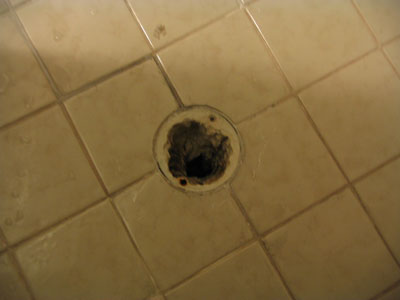HOW TO ENLARGE THE WEEPHOLES IN A CLAM SHELL TYPE DRAIN
When do you use a clam shell drain?
When tiling a shower stall, the floor that you stand on is called a pan. The plumber installs a two part, cast iron drain system called a clam shell drain. To see an example of a cast iron clamshell drain go here: https://www.oatey.com/shower_drains/lit/subs/151Series.pdf
For best results, this drain is installed as close to the center of the stall as possible. Next, the hot mop person inserts three 16 penny nails in the three weep holes and bends them upward to keep them in place. Then, the hot mopper puts layers of hot tar and felt across the pan and between the two parts of the drain for a tight, leak-proof system. The hot mopper is required, by code, to slope the tar so that water drains from the perimeter edges of the pan downward towards the drain. The membrane of waterproofing that covers the inside diameter of the drain is later cut away with a knife and a plug is placed into the drain. Then, the pan is filled with water, above the top of the drain, but about an inch below the curb. Water sits in the freshly tarred pan for at least 24 hours as a water test to see if any leakage occurs.
What are weep holes?
Weep holes are tiny holes in the cast iron drain that you can see if you hold a two part clamshell drain in your hands and look at it sideways. If you look closely, you can see the tiny holes formed at the juncture of the two parts joining together.
What are weep holes for?
When the resident takes a shower, water hits the pan tile and grout. It seeps through the grout joint, goes down through about 1 1/2 inches of mortar bed, hits the sloped tar pan and is supposed to drain through the weep holes. Unfortunately, these holes are not designed properly. They are not big enough to prevent the future build up of hard water deposits and minerals that naturally come from the water. Over time, sometimes a very short period of time, the hard water and minerals in the water build up and these weep holes become severely blocked.
See photos below of severe build up of minerals and hard water deposits.


Why do we need to enlarge the weep holes?
When the weep holes are blocked, the water builds up in the mortar bed of the pan and after repeated showers, the hydrostatic pressure builds up and the water start to run upwards and take the path of least resistance. Usually this means the water goes up and over the curb. But, this happens under the mortar, so it is very subtle and not within sight until the damage becomes severe. Then, you will see soft sheetrock at the sides of the curb, or a bulging curb with tiles splitting, grout joints enlarging, or shaded, dark linoleum where the water damage is underneath the finish surface. On a two story house, with the shower on the second story, you can have compounded damage to the ceiling of the first floor living areas.
How do we enlarge the weep holes?
Before laying the mortar bed, pull the nails out of the three weep holes. Take a drill with a sharp 1/4 inch bit, hold it sideways as close to the tar pan as possible. See picture. It is very important not to hold the drill too upright or you’ll damage the waterproofing. Aim for the tiny existing weep holes in the drain. The wall of the drains are made with cast iron so the bits will drill through it but it takes a little time, so be patient. It takes no more than 15 minutes to drill all three weep holes with a new bit. After enlarging the holes, throw the bit away.

Notice how I am holding the drill at such a low angle that the chuck actually lightly rubs the tar pan. It is important to use this low angle so as not to drill in the wrong place and cause a leak.

Now, don’t forget to protect these new enlarged weep holes.
